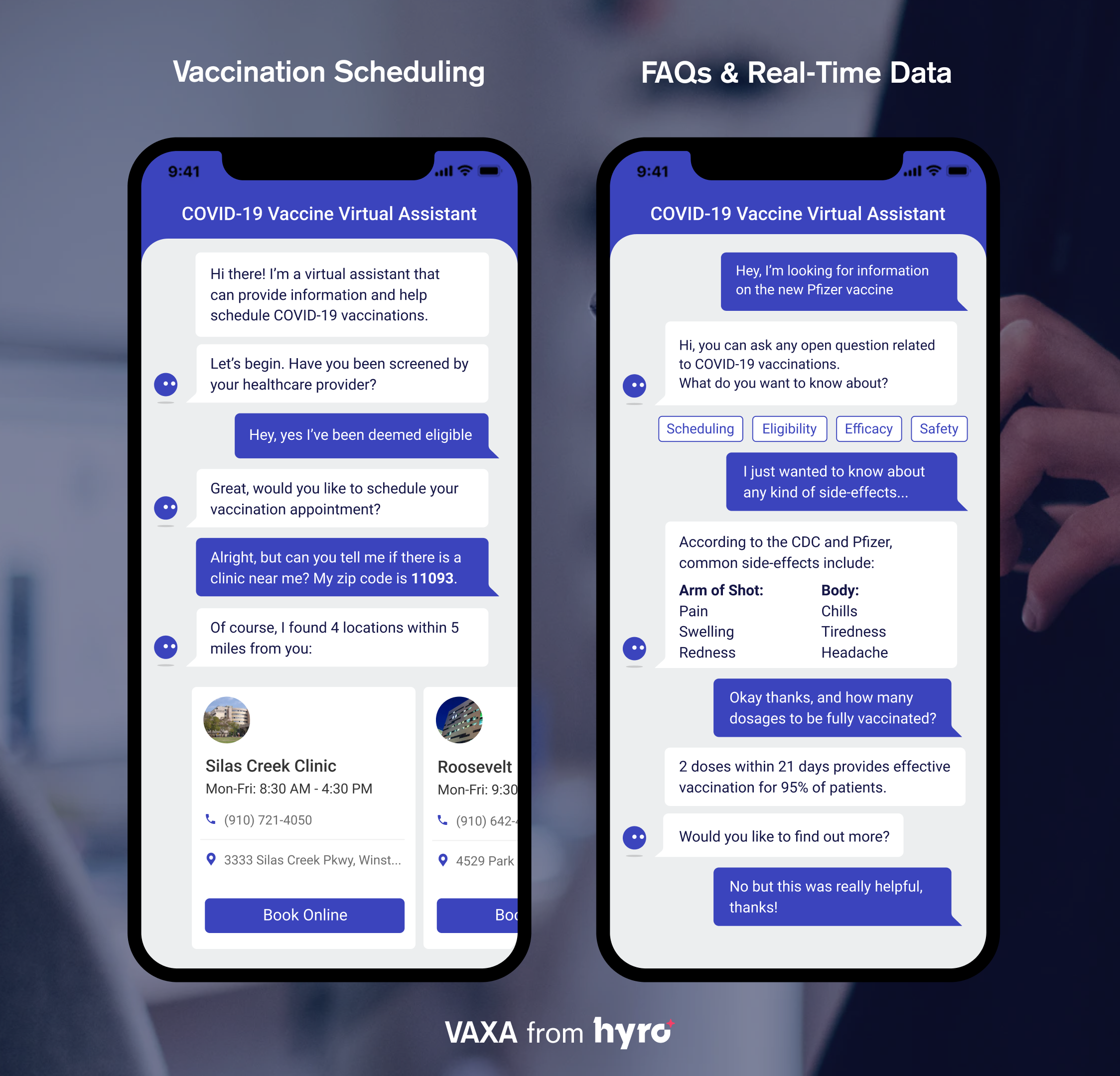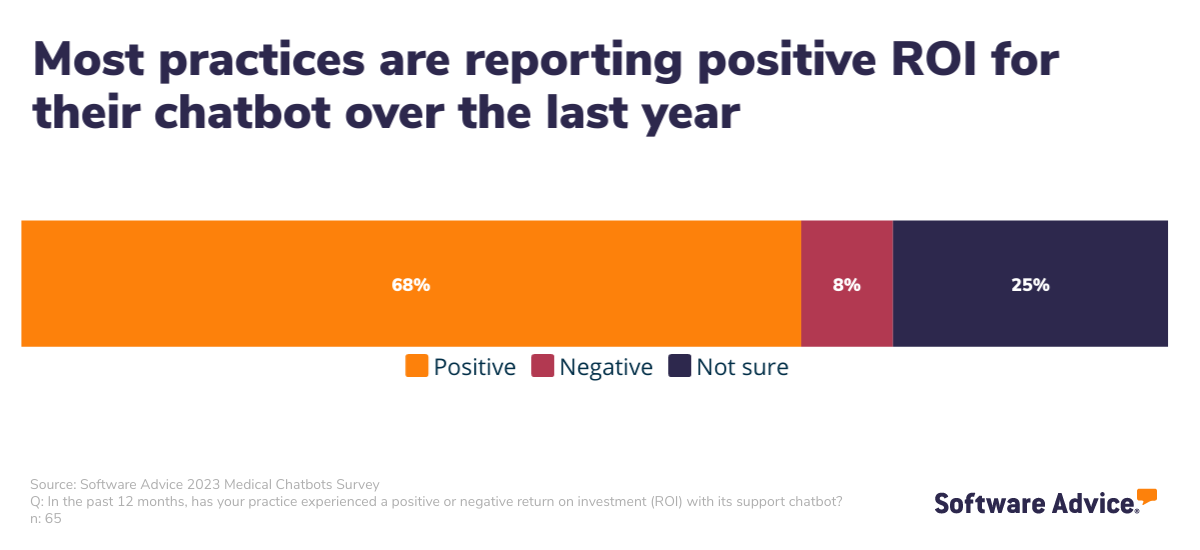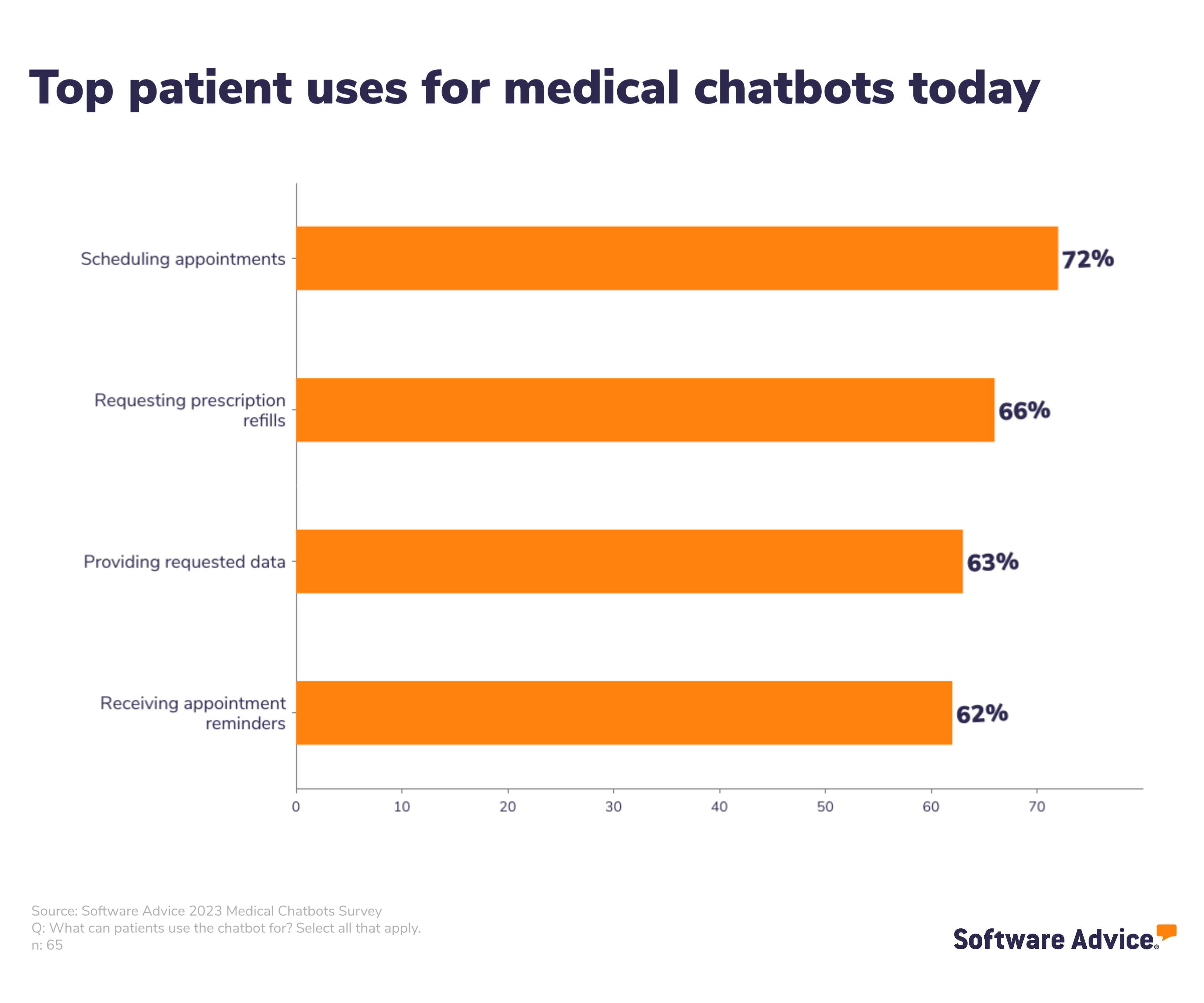Chatbots and Their Impact on Healthcare
Healthcare organizations around the world are utilizing chatbots and are seeing positive results and a return on their investment. As greater strides are made into natural language processing and artificial intelligence (AI), the usage of chatbots will only continue to increase. Being an early adopter of the healthcare chatbot will help you stand out from the crowd while also helping you improve your patient engagement and practice management capabilities.
If you’re a small-practice owner who has a passing understanding of what a chatbot is and how it functions, but you’re not sure how they’re being used by other healthcare professionals (or how you could best use it), our Software Advice 2023 Medical Chatbots Survey* has all the answers.
Definitions and different types of chatbots in healthcare
Chatbots in healthcare are used to allow patients and practitioners to communicate more effectively and easily. They are primarily a tool used to improve practice management, but can also assist in diagnosis. Communication can be done either through a chat window on your patient portal or home page, or, in many cases, the healthcare chatbot has functionality that will enable your patient to call, text, email, or video conference your practice all without you or your staff having to lift a finger.
There are two main types of chatbots that see use in healthcare service: Rules-based chatbots and chatbots powered by artificial intelligence (AI).

An example of a chatbot being used in healthcare (Source)
Rules-based chatbots
Rules-based chatbots follow a decision tree matrix to guide patients to a specific action. These rules are a script that’s been determined in advance and do not change unless you or your chatbot admin change the script.
Rules-based chatbots are great for any healthcare provider who needs to get a better handle on incoming patient queries because they are often used to answer simple patient questions such as “what are your hours of operations?” or “how do I schedule an appointment?”
AI-powered chatbots
AI-powered chatbots use natural language processing technology to interpret the meaning and intent of what your patient is asking in real time to provide the most natural, helpful response.
These conversational AI chatbots are often more sophisticated and can assist patients in a wider variety of issues and can function as a virtual assistant for you and your patients.
Ultimately, a conversational chatbot is a tool you can utilize to improve patient engagement while increasing you and your staff’s efficiency by freeing your team up to focus on other important things.

What are the different ways chatbots can help your practice?
Chatbots can be an elegant and effective way to improve patient engagement at your practice while also increasing you and your staff’s level of efficiency. The investment can even help save you money in the long run. In fact, according to our Software Advice 2023 Medical Chatbots Survey*, 68% of practices found that they had a positive return on investment for their chatbot over the last year.

However, not all chatbots are going to do the same thing, so it’s important to understand the different ways chatbots can improve your practice.

Let’s break down what each of these uses mean in a more practical sense:
Easy access to self-scheduling for your patients: Patients who visit your website or app can access your healthcare chatbot to plan and schedule an appointment. In fact, 55% of practices who use chatbots for patient self-scheduling are saving at least an hour of time per week*.
Patients have better access to important health information: Your chatbot can be used as a location for FAQs where patients can ask common questions about procedures and the chatbot gives them instant answers that they want, which frees up your staff. They can also easily access their patient data without needing to talk to your staff.
Chatbots can assess patient symptoms and suggest the best course of action: Patients can get medical advice from a chatbot by inputting their symptoms into the text field, and the chatbot can alert them if they should seek immediate medical aid or schedule an appointment.
Automatically refill patient’s prescriptions: Chatbots can contact pharmacies in order to determine whether or not a prescription has been refilled. If it has, it will automatically alert your patient so that they can pick it up.
Chatbots can collect patient intake information: Once a patient has self-scheduled, chatbots can collect patient intake information which saves your office staff time later down the road and makes the check-in process more efficient for the patient.
The increased efficiency a chatbot offers your practice is nearly invaluable when it comes to saving you and your staff time. Either type of chatbot should be able to provide all of these benefits, but an AI-powered healthcare chatbot will be more equipped to help with the more complicated diagnosing.
Rules-based chatbots, if scripted well, can help you with self-scheduling, prescription refilling, and patient intake without much issue.
Drawbacks of chatbots in the medical field
While the research shows that chatbots are, overall, gaining increased ROI for most healthcare providers and helping patients navigate their healthcare options in a more meaningful, efficient way, it would be naive to not acknowledge that chatbots can come with a few drawbacks.
Lack of human interaction: The lack of human interaction can make your patients feel less heard. It can also lead to a disconnect between your patients and your staff. If your patients are getting their questions answered or scheduling their appointments via chatbot, they’re less likely to feel personally invested with you and your staff.
Cost matters: If you’re on a tight budget and aren’t feeling overwhelmed by calls, prescription requests, or scheduling, you simply might not need a chatbot. Although medical professionals are seeing increased ROI, it’s still an investment and more expensive than having staff members available to answer questions via the phone or through email.
It can negatively impact patient experience: We’ve all experienced frustration with automatic responses that don’t quite answer the question you’re asking. This is primarily an issue with rules-based chatbots that aren’t programmed with the correct scripts, but it can be a major downside for patients if they aren’t able to find the answer they want quickly.
Lack of understanding and buy-in from your patients: Your patients may just simply not trust that a chatbot can provide them with the information they want, or they might be worried that the information isn’t accurate. While you can guarantee that the information is accurate, some patients, particularly those who are generally averse to technology, might not trust chatbots.
Ultimately, these drawbacks are relatively minor and can be addressed in a few simple ways. Providing educational resources for your patients about how best to utilize the chatbot goes a long way in making sure they are able to get the most out of it. Additionally, your chatbot should never be the only way that a patient can contact your office. Some patients won’t ever want to use it, and that’s okay.
Questions to ask before investing in chatbots for your practice
Chatbots, especially rules-based chatbots, are a relatively low-cost, low-effort way to improve efficiency in your practice, but that doesn’t necessarily mean you need to jump on board immediately. This is particularly true because as AI-powered chatbots become more and more ubiquitous, the cost will go down while their accuracy and ability to interpret human language and intent increase.
Ask yourself a few different questions before taking the plunge
Are you and your staff overwhelmed by administrative tasks such as refilling prescriptions, answering phone calls, or scheduling appointments?
Are my patients going to be on board with learning a new way to interact with my office, or are they typically resistant to technology?
Do I have the bandwidth to monitor the accuracy of the chatbot and ensure that the script is accomplishing what I need it to do?
Depending on your answers to those questions, it might be time to start looking around at the different options available to you. Luckily, many of the major EHR providers already have chatbot functionality built into their products, but if your EHR provider doesn’t have that option available, many of the standalone chatbots can integrate with your EHR, patient portal, and/or your website.
Chatbots in the healthcare sector aren’t going anywhere anytime soon
Nearly half of the practices we surveyed use chatbots to allow their software to collect patient symptoms and assess them, escalate urgent cases, and advise patients on how to handle the less severe symptoms*.
That alone should be enough to show you that chatbots are going to become a much more crucial part of the healthcare sector diagnosing tools.
Not only will a chatbot save you time and money, but it will also help you stay on the cutting edge when it comes to more advanced ways to provide better care for your patients.
If you’re interested, you can start by comparing existing chatbot platforms to find the best chatbot technology fit for your practice.
If you need a bit more information before taking the plunge, check out these other resources about artificial intelligence and advanced technology in the medical field:
Survey methodology
*Software Advice’s 2023 Medical Chatbots Survey was conducted in March 2023 of 65 doctors, therapists, or practice owners/founders who currently use live chatbots on their websites. The purpose of this survey was to gauge awareness of AI chatbot tools, assess the most valuable applications in use today, and find out how medical professionals feel about the potential of AI-powered chatbots, such as ChatGPT, to help manage and run a medical facility.
We used screener questions to narrow respondents down to doctors, therapists, or practice owners/founders with relevant experience related to chatbots.
Note: The screenshots of applications included in this article are examples to show a feature in context and are not intended as endorsements or recommendations.